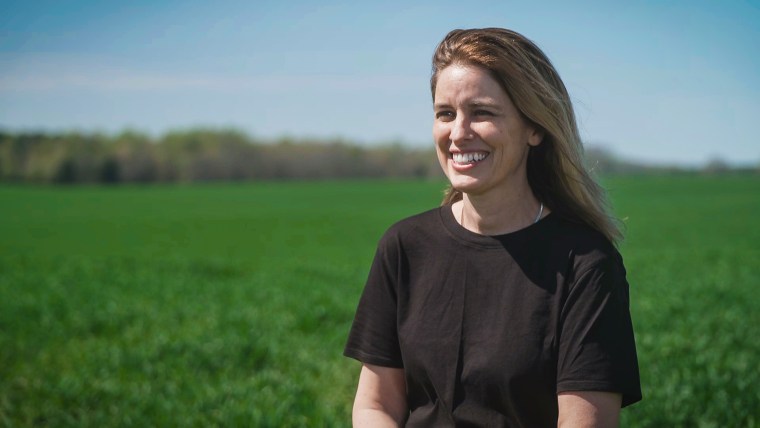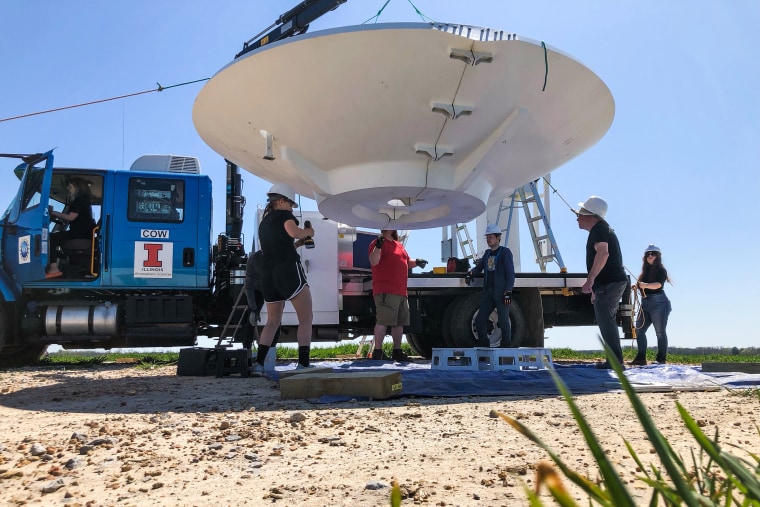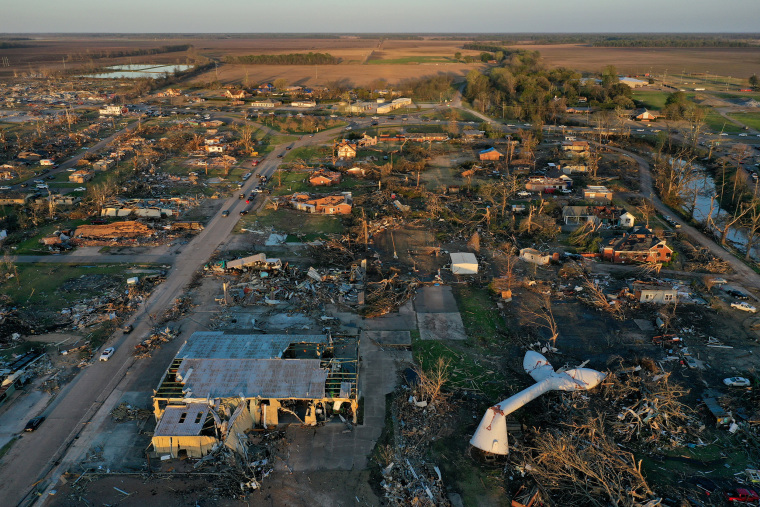It was a brilliantly sunny day as Karen Kosiba and her team unloaded and assembled a huge satellite dish in a sprawling field on Thursday just outside Saint Joseph, Tennessee. But over the next few days, these researchers are hoping their setup will be right in the path of a tornado.
Kosiba, an atmospheric scientist at the University of Illinois Urbana-Champaign, is leading a research group to study how tornadoes form and evolve in the southeastern United States, and how to better protect the communities that may be in harm’s way.
“Our goal is to be right in the path of the storms,” Kosiba said. “We’re hoping that they’re producing tornadoes not on us, but very near where we’re collecting, where we’re set up.”
That may sound like a scene ripped from the movie “Twister,” but storm chasing has for decades been a valuable — if hair-raising — way to study features of a tornado. But scientists like Kosiba are keen to understand what precisely it takes to create these intense rotating columns of air before they ever touch down.
The project, which began in 2022, has taken on greater urgency after a series of deadly tornadoes ripped through Mississippi and Alabama last week, and as violent tornadoes touch down with greater frequency in the Southeast.

The two-year campaign is known as PERiLS (short for Propagation, Evolution, and Rotation in Linear Storms) and includes work by the University of Illinois and eight other universities, all supported by the National Science Foundation and the National Oceanic and Atmospheric Administration.
The researchers try to deploy a suite of instruments in parts of the Southeast ahead of forecasted storms, then gather data as they blow through in hopes of understanding how and why some storms spin up intense tornadoes.
Kosiba’s work is focused on an area that stretches from southeastern Missouri down through Arkansas and Louisiana, and east into Mississippi, Alabama and Tennessee, at the foothills of the Appalachian Mountains.
These regions are particularly vulnerable to tornadoes because there are more tightly packed towns and cities across the Southeast compared with the Great Plains, another area where tornado outbreaks often occur. Intense storms can also cause catastrophic damage in this part of the country because more people live in weaker housing structures such as mobile homes and manufactured housing.
“Knowing more about the storms in the Southeast is really critical because it’s a high population density out here,” Kosiba said. “So, these storms have the potential to impact many more people.”

The work is timely. A study published Tuesday in the Bulletin of the American Meteorological Society found that supercell storms, like the ones that spawned the tornadoes in Mississippi last week, will increase as the world warms. These storms will also shift east, hitting Southern states like Alabama, Mississippi and Tennessee more frequently in the future, according to the study.
Kosiba and her colleagues have deployed around 50 instruments in this part of the Tennessee Valley, nestled against the border of Alabama. Together, they will collect observations ranging from wind conditions and temperature to moisture in the atmosphere before and during storms.
“And we’re looking at the storm structure and saying: Where is rotation potentially happening?” she said. “And does that relate to something in the environment?”
If scientists can better understand why tornadoes form when they do, and what fuels their paths when they touch down, researchers could create more precise forecasts. That, in turn, can save lives.
Chris Weiss, a professor of atmospheric science at Texas Tech University, is conducting similar field research in northwestern Alabama and southern Tennessee. His work, like the PERiLS project, is part of a broader effort at NOAA to examine the conditions that make tornadoes particularly dangerous in the Southeast.
Recently, Weiss and his team were dispatched to eastern Arkansas ahead of an outbreak of small tornadoes in the area. Last week, the researchers were stationed north and south of Rolling Fork, Mississippi, the small Delta town where a tornado tore through at night, causing more than two dozen deaths.
In addition to gathering valuable science, such as readings on temperature, air pressure, moisture and wind, Weiss and his colleagues are also studying how to improve the way tornado threats are communicated to the public.
“We’re trying to understand better not just the physical causes for these tornadoes but also some of these more social aspects,” he said.
For instance, the researchers want to know how tornado warnings are received by communities, how they are acted on, and if places have adequate access to storm shelters.
Layering scientific research with behavioral and societal factors is becoming a key priority among researchers who study these kinds of extreme weather events, said William Gallus, a professor of meteorology at Iowa State University.

“We used to have a bad habit where we only focused on the science, and we would pat ourselves on the back that our warnings have become so good,” Gallus said. “But that’s really a minor piece of the puzzle. The important thing is getting the information to people and making sure they can actually act on it.”
In the long run, the idea is to avoid the type of worst-case scenarios that can play out when violent tornadoes rip through vulnerable communities — as happened last week in Mississippi and Alabama.
“It’s just heart-wrenching,” Weiss said about last week’s aftermath. “But, it provides motivation for what we do. It spurs on what we do to try to better understand how we can warn better and more effectively. That’s really the spirit of this project.”

